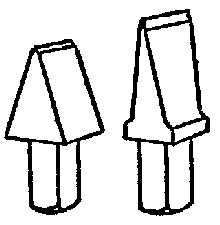
Blacksmithing is a skill in which various articles are forged from wrought iron or steel. The blacksmith uses various tools to create the items that are made. They include the blacksmith hardies, chisels and punches.
Blacksmith Hardie
The term hardie also spelled “hardy”, may be used to describe the tools used in the square hole in the anvil referred to as the hardie hole. The Hardie hole is a valuable “tool” for the blacksmith because it is the place where the tools used in particular methods of blacksmithing, are placed. Hardie holes usually come in different diameters, so it is important to know the size of the hole required before acquiring the correct hardie that will fit.Blacksmith hardies, are the tools used by a blacksmith in the hardy holes usually located at the back of the anvil. Other names that are used to refer to these tools, are called anvil sets or bottom sets. They have various uses, hence they are shaped differently, depending on what they will be used for. Some of these anvil sets are used as cutting tools (for example: a steel -cutting tool that is small in size with the cutting edge facing upwards), others being designed for shaping or bending, and still others for flattening the work pieces. Hardies can also include cut-off tools that have a wedge shape that cuts through the hot steel. Another variation is the “swage”, which can come in a variety of shapes, some being specially designed to enable you get a preferred shape on the hot steel.
Blacksmith Chisels
The blacksmith uses various types of chisels for chipping away the metal surface to produce desired shapes. The handled cold chisel, for example, will be used for cutting or chipping cold metal on an anvil. This type of chisel has a wooden handle which is fabricated in two sizes. The handled hot chisel will only be used when the blacksmith needs to cut hot metal. It is usually more rugged and much heavier than a handled cold chisel. Another type, the track chisel; has a handle that is 24 inches long and it is used mainly to cut off boiler rivet heads and track bolts. It also cuts thicker pieces of metal in case a cutting torch or a saw is not available. The rivet buster chisel is designed with a longer cutting edge which is 3/4inches wide and 9 inches long, designed to reach chassis rivets.
Blacksmith Punches
Blacksmiths use punches mainly for making tools that will have a handle or any moving parts. There are two main punches, the handled punch and the hand-held punch. The hand-held punch is basically a metal rod that is shaped and tapered to make a blunt end. A punch however can vary in shape at the punching end, from triangular, oval, rectangular and square shapes. The handled punches were developed because the hand-held punches would have obscured the blacksmith’s view of the work piece being punched.Punching can be done to make holes or to create decorative patterns. For example, a blacksmith will punch a hole in the rod or bar that will be used for the hammer handle when making a hammer head.